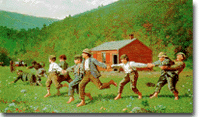How Did Art and Literature Change During the 1800s

38f. Artistic and Literary Trends

Butler Institute of American Art
Winslow Homer drew several versions of "Snap the Whip," capturing school children at play in 1872 rural America.
Similar the American economic system, American fine art and literature flourished during the Gilded Age. The new millionaires desired profoundly to replenish their mansions with beautiful things. Consequently, patronage for the American arts was at a higher level than any previous era. Painters depicted a realistic look at the glories and hardships of this new historic period. Writers used their pens to illustrate life at its best and its worst. The cyberspace result was an American Renaissance of arts and letters.
Painting the Gilded Historic period
Many wealthy Americans yearned to have their image captured for posterity by having their portraits painted. James McNeill Whistler and John Singer Sargent were the most sought subsequently portrait artists of the fourth dimension. Lured by the idea of working among European masters, both moved to England. Their works endure as amidst the finest in the genre. Another expatriate American was the impressionist Mary Cassatt, who moved to Paris to work with the masters Monet and Renoir. Beyond any creative person of the age, she captured women and children at their tender best.
Perhaps the nearly famous of the postwar American painters was Winslow Homer. Homer gained fame during the Civil War for his realistic illustrations of Union soldiers, which ofttimes graced the covers of Harper's Weekly magazine. After the state of war he became a serious painter. Life in the American countryside was made existent to those who flocked to the cities. His afterward years were marked with a fascination of the New England declension. Probably no American painter captured the majesty and ability of the sea like Homer.
At the aforementioned time, Philadelphian Thomas Eakins illustrated local behaviors, including a series depicting crew races on the Schuylkill River. His most controversial work, The Gross Clinic, depicted a alive medical operation.
Literature
In literature, the dominant figure of the historic period was Marker Twain. Born Samuel Langhorne Clemens, Twain spurned the stodgy New England writing style of the time and brought an added bear on of realism by writing in the local color and manner of the American Mississippi. Huckleberry Finn and Tom Sawyer became genuine American folk heroes to his many readers.
Kate Chopin was largely unknown at the time, simply her novel The Awakening became a manifesto for future feminists. Stephen Crane portrayed the horrors of the Civil War with his poignant The Red Badge of Courage in 1895. Henry James struggled with the values of the Victorian Historic period by focusing his attention on women. His works Daisy Miller and Portrait of a Lady hinted at the tension lying beneath Victorian morality. The horrors of city life were grimly depicted in Theodore Dreiser's Sister Carrie , whose representation of a poor working girl offended many a reader.
Postwar poets were prolific. Most notable were Walt Whitman for his Leaves of Grass collection and Emily Dickinson, whose many poems were published after her decease.
In the Abode
The visual arts flowered as well. The market for interior design was booming. Louis Comfort Tiffany specialized in stained glass. He combined glorious colors of glass with shells and stones to create cute works for fine homes. He was even commissioned to improve the interior of the White House. Candace Wheeler pioneered work in tapestry weaving. Wealthy Americans bought these items with a fever, and lavished their homes with marble floors and decorative chandeliers. The American Renaissance was in full swing.
![]()
If you lot similar our content, please share it on social media!

![]()
Source: https://www.ushistory.org/us/38f.asp
0 Response to "How Did Art and Literature Change During the 1800s"
Post a Comment